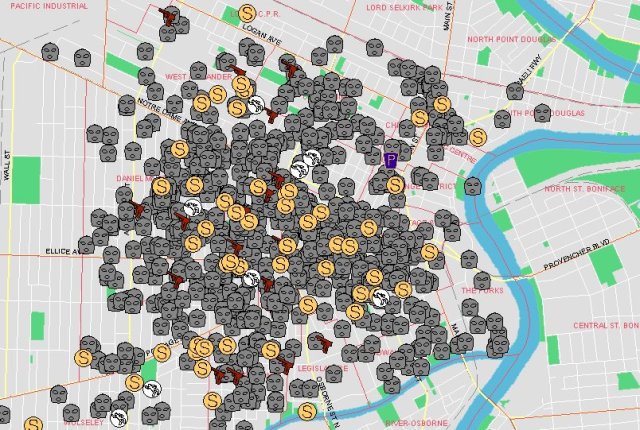All it takes is a glance at the Winnipeg Police Crimestat website to see that there is no real surprise here in terms of the recent shootings in the City’s West End. And certainly no need on the part of the police to be shocked as they recently claimed.
When it comes to homicides, shootings, sexual assaults and muggings (the four main crime types being tracked by Crimestat that are classified as “crimes against persons”), Crimestat tells the public exactly what most police officers working in Divisions 11 and 13 are already aware of. These four specific types of crime occur with alarming frequency in Districts 1 and 3 and more specifically in rather small geographical areas within those two Districts. As seen below, the first Crimestat map makes that point:
City wide map showing homicides, shootings, sexual assaults and muggings from June 16th 2009 to June 14th 2010.
Source: Winnipeg Police Crimestat website
The above map shows two very distinct data clusters, one in District 3 and an even larger one in District 1. The two maps below show a close up of those two areas and leave no doubt as to the high number of homicides, muggings, shootings and sexual assaults.
Crimestat map showing homicides, shootings, sexual assaults and muggings in a portion of District 1 for the period June 16th 2009 and June 14th 2010.
Source: Winnipeg Police Crimestat website
Crimestat map for a portion of District 3 depicting the same four offences for the same period:

Source: Winnipeg Police Service Crimestat website
These two Districts, and primarily the concentrated areas of the two districts shown above, account for 70% of all homicides, 68% of muggings, 55% of sexual assaults and 88% of all shootings in the entire city for the period between June 16th 2009 and June 14th 2010.
Still shocked about what happened recently in the West End?
The police response has been predictable. More officers, more guns, more arrests, more seizures. In other words, more visible evidence of police activity. In the next little while we will be seeing reports and statistics outlining those numbers as a testament to the efficiency and effectiveness of the approach being taken by police.
Ask yourself, is it really effective in a long term sense? Can you arrest your way out of a social problem?
Sir Robert Peel suggested a measurement to test police efficiency that concentrated not on statistics listing police activities but rather a measurement of the level of crime (or lack thereof) in the community. Peel’s Ninth principle says:
To recognize always that the test of police efficiency is the absence of crime and disorder, and not the visible evidence of police action in dealing with them.
Let’s make sure we don’t get too dazzled by the activity. Let’s look down the road and measure what is being done in the West End based on outcomes. In this case, the absence of crime.

